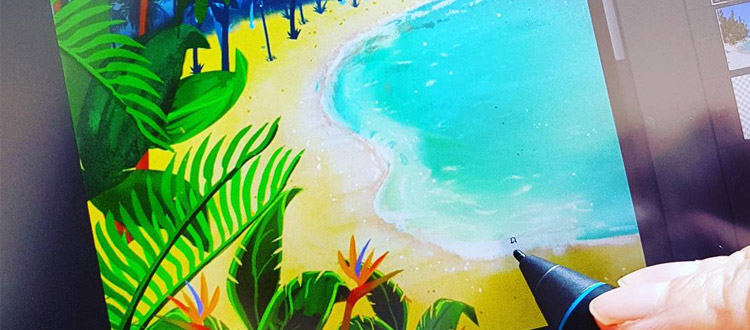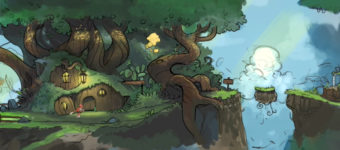
Best Books On Layout & Background Painting For Animation
Background painters are a vital part of the animation process. If you’re hoping to become a background painter then you’ll need a solid background in digital painting along with the basic fundamentals.
But to create truly magnificent backgrounds you’ll want to study work from the greatest animators in history.
In this post I’ve curated the absolute best books for any aspiring animation background painter or layout designer. These books touch upon composition, setting, layout, style, and how to create a background that perfectly replicates a cartoon’s atmosphere.
The Noble Approach


Maurice Noble is one of the classic old-school background painters working on Warner Bros and MGM cartoons. His career stretched over 60 years in animation and his backgrounds are some of the best around.
The Noble Approach is a 170-page volume of Maurice’s work from dozens of classic cartoons. You can study his layout styles from Bugs Bunny and Roadrunner cartoons along with many more.
There are plenty of pictures but there’s also lots of excerpts from Maurice’s writings which were meant to be published in a memoir. Sadly he died before this could be completed. But his writings live on in this tribute to one of animation’s finest layout designers.
You’ll learn everything about Maurice’s approach to animation from concept designs to the final frame of every feature. There’s a ton of original artwork including sketches and production concepts detailing the process from start to finish.
If you’re an aspiring animator looking into backgrounds then you’ll love this book. I consider it a staple for anyone interested in layout design.
Layout & Background


If you’re more of a Disney animation fan then Layout & Background might be more your style. In this book you’ll find more than 300 pieces of unique artwork covering layouts dating back to Snow White and up to more recent films like Tangled.
Dozens of talented background painters have their work featured in this book. It’s the first of a series of books released by Disney’s archive collection.
Print quality is clear and very easy to follow. The page material is also thick enough that the images don’t bleed through to each side.
This is not a “how to” book and doesn’t have much practical advice. However it can provide a lot of inspiration for aspiring artists hoping to break into the industry.
Setting the Scene


This is one of the best animation books packed with rare facts and background paintings from decades of animated films.
Setting the Scene: The Art & Evolution of Animation Layout is a huge title with almost 300 pages full of background paintings and production artwork. This book is massive and includes tons of unpublished artwork from studios like Disney, Warner Bros, and Pixar.
You’ll also find incredible interviews with rare industry legends sharing their tips on how to animate, set the scene, and paint a layout that fits accordingly.
This book really takes you on a journey teaching about the history and layout structures of different films. But it also offers genuine tips for aspiring artists who want to learn from industry veterans.
Setting the Scene is basically required reading for any animator. It offers tons of inspiration and can help you on the path to a career in animation.
Layout and Composition for Animation


I really like Layout and Composition for Animation as an inspirational art book. I do wish it had more information about laying out a scene, but what you do get is well worth the price.
Note this is an exceptionally simple book. It shares a lot of production art along with background paintings and samples from real classic animated films. You can learn a lot about sequential storytelling and how animated stories are created.
But the author does not share super practical tips. His tips might be useful to some animation students but they’re few & far between.
I really like this book for the artwork and the concept designs. I think it would be a hundred times better if the author wrote in more detail, but I still think this is an excellent read for aspiring background painters and layout designers.
Set the Action!


Here’s a much broader book covering backgrounds for everything from games to animation and even comics. Set the Action! covers 240 pages of exercises and discussions for aspiring layout designers.
Most of the book focuses on graphic novels and comic books.
However all of these tips still apply to animation and they’re crucial for storyboard artists. You’ll learn how layouts affect the story and how characters need to be placed appropriately to look good in the scene.
If you already have a solid understanding of perspective and shading then you can breeze through these exercises. But the golden nuggets are the little tips you pick up along the way about composition and layout design.
The Animator’s Eye


This book is basically the ultimate guide to animation. It covers thumbnails, storyboards, animatics, coloring, sound, and timing(plus a whole lot more).
The Animator’s Eye by Francis Glebas is a must-own resource for any aspiring animator whether you want to do boards or character or backgrounds. This book really does have everything and I’ve yet to find another title covering this much material.
Francis talks about storytelling and how this applies to animation. He explains how animations should be created and what it takes to master the art of animation. By reading through this book you’ll learn all the terminology and how to setup your own animations from scratch.
The chapters on composition are especially useful to background painters. But everything in this book can apply to animation so it’s really a must-have resource for anyone in the animation industry.
The Illusion of Life: Disney Animation


While this isn’t a detailed how-to book, it is a resource that can teach you a lot about animation. The Illusion of Life offers the deepest look behind the curtain of any Disney animation book.
It clocks in around 600 freakin’ pages long and includes plenty of history about Disney along with anecdotes on characters, backgrounds, sounds, voice recording, and story development.
The authors are two of Disney’s nine old men and they’re some of the most talented animators in history. This book tells their story of Disney’s rise to fame discussing how their team perfected an emerging art form to create the most successful animation studio in the world.
You won’t learn a whole lot about how to animate, but you can infer this from reading through each chapter and picking up tips from their writing.
Ollie Johnston and Frank Thomas are two deeply respected animators and this book is a treasure for any Disney fan. And it should definitely be on the bookshelf of all aspiring animators.
Magic Color Flair


Magic Color Flair: The World of Mary Blair offers a deeper look into the wildly talented Mary Blair, a concept designer and background painter for Walt Disney.
She worked for the company in their heyday creating artwork for films like Peter Pan and Alice in Wonderland. This book celebrates her work while also sharing tips and advice from professional Disney animators.
The book’s author John Canemaker is an award-winning animation director who shares the life and work of Mary through his own words.
You’ll find plenty of art tips and techniques aimed towards animators who want to break into the business. But there’s also lots of artwork and inspiration for aspiring production designers or background painters with a soft spot for Disney.
The Nine Old Men


The Nine Old Men is a book about the animators that forever changed the history of the field.
Disney’s early days started slow but they grew rapidly. To this day Disney is the top animation studio in the world in regards to quality and level of detail in animation.
This book celebrates all nine of Disney’s nine old men who are as follows:
- Les Clark
- Wolfgang Reitherman
- Eric Larson
- Ward Kimball
- Milt Kahl
- Frank Thomas
- Ollie Johnston
- John Lounsbery
- Marc Davis
Each chapter devotes 20-50 pages about their history, their career, and their unique talents. The book also has mountains of original artwork from all nine legendary animators.
In total you get about 400 pages which are just as much inspirational as they are a historic reference to the early days of animation.
This book may not make you a better layout artist but it will give you a much richer understanding of how animation works.
Dream Worlds: Production Design for Animation


This is one of the coolest production art books oscillating between a resource guide and an inspirational compendium of artwork.
Dream Worlds: Production Design for Animation uses dozens of examples from hit classics like Aladdin, Lion King, Mulan, and Hercules(among others). The book totals 220 pages filled with information about production design and layout design.
The digital Kindle version is very poor quality but the print version has magnificent glossy pages with a thick binding. It comes in paperback or hardcover and they’re both excellent.
This book specifically focuses on the imaginary worlds of animation with tips on staging, composition, and basic camera rules for animators. This all affects background painters too so it’s really a complete guide to layout design for any type of animation.
Dream Worlds doesn’t have any practical exercises or step-by-step guides to follow. But it does contain incredible artwork and suggestions for aspiring background artists who want to create professional-level work for their portfolio.
The realm of background painting is huge and it extends far into animated movies, TV shows, and shorts for film festivals. If you have any interest in backgrounds and production design then you’ll want a copy of Setting the Scene along with an informational book like The Animator’s Eye.
But truthfully I can’t just recommend one “best” choice from this list. I think all of these books are top notch resources for anyone delving into layout design for animation.
If you’re looking for practical how-to guides on digital painting then take a peek at our digital painting books list and maybe skim through our suggestions for environment designers too.











